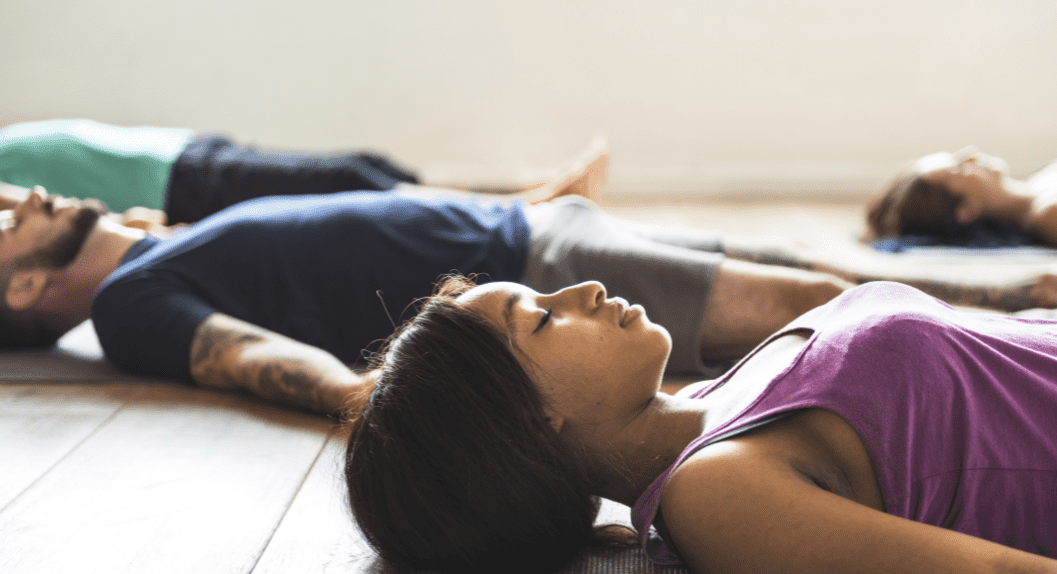What if you could shake off your stress, tension, and trauma? That’s exactly what students are doing when they practice Tension & Trauma Releasing Exercises (TRE) and Neurogenic Yoga. Both practices activate the body’s natural, therapeutic shaking response called Self Induced Therapeutic Tremors (SITT) to release tension and calm the nervous system, returning the body to a state of balance. In the following interview, Maria Alfaro, TRE and Neurogenic Yoga Certification Trainer, answers our questions about the practices designed to assist the body in releasing deep muscular patterns of tension.
What is TRE and why are these exercises effective at releasing tension and trauma? What other benefits do they have?
TRE was born out of Dr. Berceli’s experiences working with traumatized populations worldwide. He discovered that the human body tends to contract under stress. We see examples of this when people get into the fetal position. You don’t typically see someone under stress spreading the arms out. We contract under stress as an involuntary reaction. The human body is naturally supposed to let go of that stress afterward by shaking, but we tend to repress this natural reaction because of its negative social connotation.
You have likely experienced this at least once in your life during a stressful situation: if you were in an accident, you took an exam you weren’t prepared for, the cops pulled you over, after giving birth, any of those things. Natural shaking is similar to the jittery feeling you get if you drink too much coffee. We even refer to this shaking response in our common language when we say, “I was so angry I was shaking.”
You can see this reaction in little children who shake when they are scared, but since shaking isn’t socially acceptable, we tend to repress it. We numb this natural body response because we don’t want to look different or weird. We tend to shut it down rather than let it express itself in safety. The body knows how to do it but the mind is resistant. So we show people how it works by creating a safe space, and TRE and Neurogenic Yoga allow this response to become aligned again.
Could you explain how TRE activates the body’s natural, therapeutic shaking response?
The exercises are a series of standing exercises inspired by different modalities that are designed to fatigue or stretch muscle groups in the legs. The combination of gentle fatigue and stretching helps to activate the response.
TRE is a simple routine in which you stretch or fatigue the quadriceps, hamstrings, calves, and ankles, and then lie down in certain positions. The shaking response just comes on, sometimes before participants are on the floor. The mind is sometimes a resistance to this practice. The mind can say, “This is ridiculous.” But where does this thought come from? The body or mind?
We’re not looking for a big boom. TRE and Neurogenic Yoga offer an integrative, gentle, mellow, gradual way of releasing tension from the body.
What is the difference between TRE and Neurogenic Yoga, and what led you to incorporate Yoga with the self-induced tremors?
I’ve practice Yoga since 1986 and began teaching in 1997. I was already a Yoga teacher long before I became a TRE teacher. I began working with Dr. Berceli in 2004, and he asked me and another teacher to create Neurogenic Yoga.
In TRE, there is always the same routine: there are 7 exercises, though these can be modified to accommodate folks. In Neurogenic Yoga, we use Yoga poses and pranayama, taking a new approach. You can combine the tremors with any kind of Yoga you like to do already—Ashtanga, Bikram, Kundalini, and/or Integral. There would be 15 minutes of shaking followed by a 2 minute savasana (corpse pose).
People ask me what program should they do, TRE or Neurogenic Yoga. Neurogenic Yoga is for people who like Yoga. Not everyone likes Yoga, so then I would suggest TRE. Overall, the practices are similar and the effects are similar.
Neurogenic Yoga™ is a practice that facilities the lengthening and relaxation of the psoas muscle and the release of physical and emotional stress and tension. What effect does the lengthening of the psoas muscle have on the body? Why is this important?
The psoas is the most important anatomical piece to releasing tension in the body and mind. The brain produces cortisol and adrenaline in a situation of stress as a part of the fight-or-flight response. That feeling of stress should go away, but many people’s brains are continuing to produce those same chemicals, which keeps the body in a state of stress. Thus, they still feel and act as if they are in a dangerous situation. The psoas is the main muscle of the fight-or-flight response. The psoas remains tight while all this is happening in the body and it contracts in preparation to run. It is also connected to the diaphragm, which affects one’s breathing.
In the practices, we really don’t do anything to the psoas—the psoas benefits passively from the exercises. When we release the legs, the psoas relaxes also. The psoas doesn’t benefit from active, or forced, lengthening. The positive effects are cumulative—the more you do the practice, the more the psoas relaxes. When you actively manipulate it, it relaxes and then comes back tighter.
The problems that come from a tight psoas—both physical and emotional—seem to be helped by this work. A tight psoas muscle can cause many problems in the body. Problems with digestion, the reproductive system, insomnia, fatigue, and fibromyalgia may be directly or indirectly related to or caused by a tight psoas. Emotional problems such as anxiety, PTSD, irritability, and bouts of anger are also correlated with a tight psoas. By practicing TRE and Neurogenic Yoga, people report, among other things, sleeping better, less pain, better digestion, and reduced anxiety attacks. All these problems are ultimately stress-related, and the tremors encourage relaxation of the psoas and the body overall.
TRE and Neurogenic Yoga have been described as self-regulatory. How so?
Basically, the participants of TRE and Neurogenic Yoga should do the practices in a way that works for them. They should never feel pain during the practices. It’s something I always emphasize when I do the introductions to the practice. Pain would cause the body to contract and resist. It’s okay if emotions come up during the practice—it happens sometimes—but if it becomes uncomfortable, stop. Take a break. Some people have trepidation about doing this kind of work because they are concerned about “losing control,” but the truth is that they only do what they feel comfortable doing,
The whole point of these workshops is that people learn to reactivate the tremor mechanism in their body, learn to regulate it and feel comfortable with it, and then take it home. Regular practice brings big benefits. If you do one workshop, you certainly get benefits for a while. But like anything, it works best if you keep doing it.



